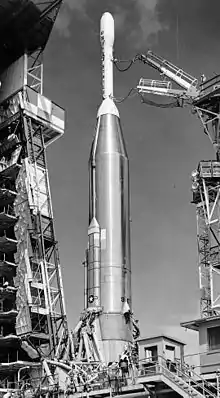Pioneer P-1
Pioneer P-1 was a failed mission in the Pioneer program. The spacecraft was a 1-meter diameter sphere with a propulsion module, and was to carry a TV camera and magnetic field sensor. It was to be spin-stabilized and was known as a 'paddlewheel' spacecraft.
 The Pioneer P-1 lunar probe | |
| Mission type | Lunar orbiter |
|---|---|
| Operator | NASA |
| Mission duration | Failed to launch |
| Spacecraft properties | |
| Manufacturer | TRW Space Technology Laboratories |
| Launch mass | 168 kg (370 lb) |
| Start of mission | |
| Launch date | 24 September 1959 (pre-launch failure) |
| Rocket | Atlas C-Able #9C |
| Launch site | Cape Canaveral, LC-12 |
The spacecraft was intended for launch on an Atlas C-Able rocket, but this vehicle was destroyed on 24 September 1959 in an explosion on its launch pad during a pre-launch static firing. The P-1 spacecraft and an Able IV space engine were not present on the launch vehicle when it exploded, and were later used on the Pioneer P-3 mission.[1][2]

The only specimen of the Atlas C-Able rocket, intended to carry Pioneer P-1, prior to an explosion during static firing.
References
- "Pioneer P-1, P-3, P-30, P-31". Gunter's Space Page. 12 November 2017. Retrieved 9 April 2020.
- "U.S. Moon Rocket Blows Up in Test". The New York Times. 25 September 1959.
External links
- Atlas-C Able at Encyclopedia Astronautica
- Able IV information website
- Space Technology Laboratories Documents Archive
This article is issued from Wikipedia. The text is licensed under Creative Commons - Attribution - Sharealike. Additional terms may apply for the media files.
